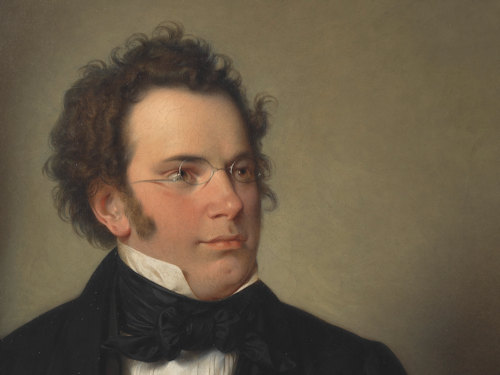
On January 31st, 1797, little Franz Schubert popped into the world at his family’s home in a small village just outside Vienna. The house is still there – firmly inside the city limits now – and features the Schubert Geburtshaus museum.
- Small, apartment-sized museum
- Various paraphernalia around Schubert’s life
- Also has an exhibition of paintings by Adalbert Stifter
- See also:
- Schubert locations in Vienna
- One-time free entry included in the Go City Vienna All-Inclusive Pass
Inside Schubert’s birthplace

(Schubert’s home until he was four)
A genius was born that day. And while other babies scream, Schubert presumably uttered more of a bravo aria.
The entrance to the house that witnessed the event takes you into a gorgeous gravel courtyard surrounded by wooden balconies, immediately throwing you back to late 18th-century Vienna. Stone stairs then lead up to a small museum dedicated to Schubert.
Colour me impressed that the historical building survives, given the real estate value of the land.
The rooms inside preserve the general 18th-century feeling with their bare wooden floors and low ceilings with whitewashed walls.
A large poster provides background information in English, but all display labels were in German on my visit: you may have to guess your way around the various paraphernalia drawn from his life and works.

(Wilhelm August Rieder’s 1875 portrait of Franz Schubert; Wien Museum Inv.-Nr. 49293, excerpt of the head area reproduced under the terms of the CC BY 4.0 license; photo: Birgit und Peter Kainz, Wien Museum)
The various portraits of Schubert on display all feature the famous round spectacles. And, lo, the very first room contains a pair he once wore.
Other highlights include:
- Music stations where you can sit and listen to some of his compositions
- School reports from 1809 and 1812, as well as his exam results from 1814. The writing is hard to read but, as far as I could tell, there were an awful lot of “sehr gut” grades (the top grade possible in the Austrian school system). But then his father was a teacher
- 1st edition sheet music for his famous Erlkönig song, as well as originals and copies of various other compositions
- A piano owned by his brother Ignaz, so you would imagine Schubert once induced its keys to produce the sounds that would later become his compositions

(Exhibition view; press photo by Lisa Rastl and © Wien Museum)
The spartan layout means you can get round very quickly: it really just gives you a taste of the life and times of the man without pretending to any degree of comprehensiveness. Consider it more memorial than museum.
But those spectacles are pretty cool.
Tickets & visitor tips
At the time of writing, a standard adult ticket for the Geburtshaus cost €5 on the door. Alternatively, get in once for free with a Go City All-Inclusive Pass (see a review).
A few tips:
- The ticket office has a small selection of items for sale: postcards, posters, CDs, pencils and a handful of books
- As everything retains its original flavor, I had some difficulty working out which doors to use (and how). Or maybe I’m getting old. Fortunately a kind attendant helped point the way
- One street down from the Geburtshaus is a building at Säulengasse 3 that now houses the aptly-named Schubert Garage (car repair shop). The composer moved there at an early age and went on to write symphonies 2 through 5 on the premises. A plaque commemorates the connection
- The Schubertkirche church is also just down the road, where he was christened and regularly performed
- The various musician locations managed by the Wien Museum also include the apartment where Schubert died
How to get to the Geburtshaus
Take tram line 37 or 38 from the big, central Schottentor station to the Canisiusgasse stop.
You can reach Schottentor on the U2 subway line, for example, or using the trams that skirt the old town (lines 1, D, 71).
Address: Nußdorfer Straße 54, 1090 Vienna | Website